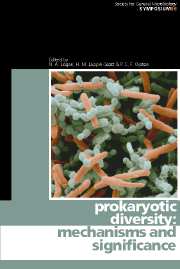Book contents
- Frontmatter
- Contents
- Contributors
- Editors' Preface
- Microbial diversity in the era of genomics
- Patterns in prokaryotic biodiversity
- A putative RNA-interference-based immune system in prokaryotes: the epitome of prokaryotic genomic diversity
- The significance of prokaryote diversity in the human gastrointestinal tract
- The genetics of phenotypic innovation
- Minimal genomes required for life
- Evolution of the core of genes
- Biogeographical diversity of archaeal viruses
- Is there a link between Chlamydia and heart disease?
- Unculturable oral bacteria
- Comparative genomics – what do such studies tell us about the emergence and spread of key pathogens?
- Spread of genomic islands between clinical and environmental strains
- Evolving gene clusters in soil bacteria
- Unusual micro-organisms from unusual habitats: hypersaline environments
- Genomic islands and evolution of catabolic pathways
- Horizontal gene transfer and its role in the emergence of new phenotypes
- Index
Evolution of the core of genes
Published online by Cambridge University Press: 06 July 2010
- Frontmatter
- Contents
- Contributors
- Editors' Preface
- Microbial diversity in the era of genomics
- Patterns in prokaryotic biodiversity
- A putative RNA-interference-based immune system in prokaryotes: the epitome of prokaryotic genomic diversity
- The significance of prokaryote diversity in the human gastrointestinal tract
- The genetics of phenotypic innovation
- Minimal genomes required for life
- Evolution of the core of genes
- Biogeographical diversity of archaeal viruses
- Is there a link between Chlamydia and heart disease?
- Unculturable oral bacteria
- Comparative genomics – what do such studies tell us about the emergence and spread of key pathogens?
- Spread of genomic islands between clinical and environmental strains
- Evolving gene clusters in soil bacteria
- Unusual micro-organisms from unusual habitats: hypersaline environments
- Genomic islands and evolution of catabolic pathways
- Horizontal gene transfer and its role in the emergence of new phenotypes
- Index
Summary
INTRODUCTION
The extravagant diversity of microbes has only been fully appreciated with the development of comparative genomics. Comparisons of gene repertoires among prokaryotes have revealed striking differences among species and even among strains of the same species. For example, the genomes of three Escherichia coli strains have been shown to share only 40% of their genes, with most of the remaining genes being strain-specific (Welch et al., 2002). More generally, although most prokaryotic genomes contain thousands of genes, only a handful can be identified as truly ubiquitous in modern organisms. This so-called ‘core’ of universal genes has received much interest from evolutionary biologists because it probably represents a relic of the last universal common ancestor (LUCA) and provides valuable information for reconstructing the tree of life. It has also been viewed as the sine qua non condition of life, since no living organism seems able to survive without it. However, perhaps more interesting is the paucity of these ubiquitous genes, as it shows the formidable evolutionary plasticity of biological systems and points to the mechanisms necessary for acquiring and generating new genes.
WHAT'S IN A GENOME?
An inventory
All cellular organisms have in common the use of DNA as the support of genetic information, RNA as an intermediate of protein expression and the same genetic code (with only a few exceptions) as well as catabolism and metabolism based on a limited number of amino acids and sugars.
- Type
- Chapter
- Information
- Prokaryotic DiversityMechanisms and Significance, pp. 123 - 130Publisher: Cambridge University PressPrint publication year: 2006

